Chapter 9: The Big City
On the Wings of the Morning
Vincent Holyoak
Bad weather was the norm at Bottesford even when other aerodromes in the locality were clear, but for several days in January 1943 all 1 and 5 Group airfields were closed in by thick, impenetrable fog. There was little to do on camp on miserable days such as these, so the attractions of Nottingham, Grantham or Newark particularly beckoned. Cliff Allen wrote:
If weekend passes were issued my mate Maxie Byrne and I always headed for Nottingham, where drinking was the main pastime. We had our meals at the Y.M.CA., and the last train back was round about 11.30, which we always missed, so that meant finding somewhere to sleep. Nottingham was crowded with thousands of servicemen, and the last hope, the Salvation Army hostel was always booked up. You wouldn’t believe the places we slept or tried to sleep, the Police Station, the General Hospital, empty railway carriages, even a telephone box. This was very cold in winter, and a bit cramped for two!
In order to break the monotony for his crew, Flight Sergeant Brian Howie RAAF, skipper of ‘A-Apple’ suggested a trip to Nottingham. Fellow Australian Ted Done, his wireless operator, takes up the story:
We booked into our usual boarding house, and then off to the well-stocked bar in tile Palais de Danse and the girls. The time came to return to the house, sleep it off catch a bus and get back to the station, but no buses were running until much too late for us, and instead army ammunition trucks gave us a lift back. On arrival we were met with tile news that we were supposed to be in briefing. The others married on, but nature dictated that I do otherwise before rushing down to SHQ, only to be confronted by an armed sentry outside the building who demanded identification before allowing me through. To my amazement there were two more inside. Never before had this happened. Hurrying forward I ran into the Station Commander as he came out of his office. He stopped me in my tracks with a ‘Who the Hell are you?’. On identifying myself and my reasons for being there he told the sentry to take my name and number and to let him have it after briefing. Turning to me he said, ‘You should be charged with causing another to fly in your place. I’ll see you later’. On entering the room I momentarily became the centre of attention, but all eyes, including mine, went back to the huge wall map showing the target. The unusual presence of the sentries was explained, for Berlin was to have our attention that night.
This marked the first attack on Berlin since the debacle in November 1941, hence the elaborate security. The clear conditions rendered the marking flares easily visible, but at the altitude the bombers were flying temperature were extremely low, around minus fifty degrees centigrade, and as a consequence Keith Thiele flying ‘D-Dog’, again found himself in trouble. On the run-in to the target his Canadian rear gunner, 21-year-old Alvin Broemeling, reported that his oxygen apparatus was freezing up. A few days before, Broemeling had found that his flying helmet had been stolen from the locker room. He was issued with a replacement by the Station Clothing Store but soon after take-off on the 16th told Thiele that his new helmet was uncomfortably tight. Thiele advised him to switch to the spare always carried on board, but unfortunately this helmet had an obsolete oxygen mask lacking the inspiratory valve fitted to newer models to. prevent freezing. .
Whilst aircrew were constantly wary of the risk of frostbite brought about by contact between unprotected skin and metal, anoxia was far more dangerous because the victim was often unaware of it. The build-up of ice in the oxygen tube slowly starved the brain of air, leading to unconsciousness and death. Mindful of this, Thiele told Broemeling to use the emergency bottles, which initially seemed to help, but by the time they began their bomb run at 19,000 feet Broemeling was again experiencing problems. The wireless operator was despatched aft to help as best he could whilst Thiele concentrated on completing the run, and the second that bombs were released, ignoring the fact that they were still over Berlin’s heavy flak defences, Thiele put the Lancaster into a steep dive. He continued to lose height until at 8,000 feet they were below the oxygen level. He then put the aircraft on autopilot and went back himself, leaving the flight engineer to keep an eye on the controls. The unconscious Broemeling had fallen against the turret doors, and with some difficulty Thiele managed to get himself half inside and lever him out. Whilst he was doing this the aircraft was buffeted by flak bursts and was actually hit twice. Having placed Broemeling on the rest bed, Thiele regained control and they limped back to Bottesford, but despite the best efforts of the crew to revive him the unfortunate gunner did not regain consciousness and when Doc Howarth, the Squadron M.O., met them at their dispersal with the ambulance, he declared that Broemeling had been dead for several hours. He was subsequently buried in St. Swithun’s churchyard, Long Bennington, the first to be interred in the special squadron plot and perhaps the most tragic because he was more a victim of petty theft than of war.
After such an eventful night there were loud mutterings on the following day when briefing revealed that Berlin was again the target. Ted Done wrote:
As A-far-Apple taxied into position for take-off each one of liS experienced churning stomachs and nervous tension, hiding his feelings as best he could. We were on our way. Mac (nav) gave Brian the course for the first leg and we settled down to our various jobs. Suddenly Brian discovered that his compass was 180 degrees opposed to the other and that we were heading for Ireland and had been doing so for seven minutes. We immediately swing around and flew back, crossing our ‘drome fifteen minutes behind the others. Normally we should not have continued, but being keyed up this standing instruction was ignored and Mac came up with a new course. ]ust before reaching Bornholm he said ‘We’re still fifteen minutes behind, the head wind must be a lot stronger than Met. gave us’. Not liking the idea of being tile last over the target and thus being prey for all the enraged nightfighters, we again decided to go against instructions and cut the comer, entering Berlin from the NW instead of the NE.
The sky was crystal clear, the stars winking, and as usual Brian was losing and then gaining altitude, swinging from side to side to lessen the chances of interception but always steadily approaching the target area. suddenly, several searchlights sprang into being, waving backwards and forwards looking for the intruder. Seconds later a brilliant blue-green light snapped directly on to us, to be immediately followed by the others. Now the flak started. The glare was intense and blinding, and from the ground it must have appeared that we were impaled on the apex of those shafts of light. Shells were bursting all around, those below lifting us with sledgehammer like blows, those beside would buffet us sideways, sometimes lifting the wing on that side with violent thrusts. By this time we had lost height and were down to 8,000 feet, nearly in reach of the lethal light flak which was now coming up at us in streams of coloured balls. For the whole of this time, standing in the astrodome and clinging to the supports, I was trying my hardest to out-guess the gunners below and issuing direction after direction to Brian, when, as with a single switch all the lights went out, the flak momentarily ceased, and we were through. Only as we straightened up did searchlights spring into being in front of uS and to the north east. The others had arrived … At debriefing we found that all the others had been late over the target because of that stronger headwind, whilst we had both increased speed and cut corners so as not to be the lone aircraft over the city! A lesson learned. This was my 27th trip, only three to go.
At the beginning of March, after over a year as Station Commander, Group Captain Swain handed over to Group Captain W.N. McKechnie GC, but before he left the Australians managed to incur ‘Ferdie’s’ displeasure in a dramatic way. Keith Thiele recalled:
I well remember the time we had a visit from some high dignitary organised by Swain. I think from memory it was a duchess, and for weeks all was spit and polish to prepare for her visit, with borders to paths whitewashed, etc. and the Officers’ Mess made immaculate. I vaguely remember the very irate Groupie arriving at the Mess at about midnight all the night before her visit to find a roaring party in progress. There were foot and bum prints on the ceiling, with the rooms covered in a generous layer of ash from the various flares that had been ignited. I don’t recall whether it was on that occasion or on another that the piano had also suffered somewhat after some irresponsible Kiwi had performed a Maori Harka on the strings …
An old Cranwellian and a contemporary of Douglas Bader, Group Captain William McKechnie bore the distinction of being the only cadet ever to win the George Cross whilst under training. In October 1929 whilst on circuits and bumps he witnessed,a fellow cadet crash his biplane and slump unconscious as it burst into flames. He immediately landed beside the unfortunate man and dragged him to safety, being badly burned in the process. In character McKechnie was a complete opposite to Swain, and could often be seen at the end of the runway waving to the crews as they took off on ‘ops’. Some aircrew would acknowledge him with a cheerful ‘V’ sign as they sped past, to which he would proffer a wide grin and a rigid salute. Section Officer Marie Cooper also took part in this nightly ritual, and in response to complaints that she couldn’t be seen, took to wearing a pair of brightly coloured Norwegian ski gloves for identification. On entering Flying Control one evening following take-off she was confronted by a throng of visiting high ranking officers accompanied by McKechnie. Not until she had given them her smartest salute did she realise that she was still wearing her gloves, and although they were a patriotic red, white and blue, they were hardly a regulation item of dress. Fortunately McKechnie was very understanding, although in future he forbade her to come anywhere near high ranking visitors!
The aerodrome received an even more unusual group of visitors one wet blustery day in March. The Lancasters were lining up at the end of the runway when a fox came streaking across the airfield hotly pursued by the Belvoir hunt. The riders, resplendent in scarlet coats and blowing horns for all they were worth looked neither to the left nor to the right as they galloped across the runway. Flying Control was far from amused and there was much swearing over the R/T from the bemused captains nursing overheating engines. The event demonstrated more than any other that even the war could not change some things.
In other ways too March was eventful. A handful of crews were drawn from’ A’ and ‘B’ Flights to form ‘C’ Flight, and placed under the command of the newly promoted (again) Squadron Leader Thiele. As regards operations, there were targets such as Berlin (three times), Essen (twice), Hamburg, Nuremburg, Munich, Stuttgart and Duisberg. On the 22nd it was St. Nazaire in France. Weather was clear over the target area with bright moonlight, good visibility and only a slight ground haze. Large fires were reported in the dock area, and the defences were gradually overwhelmed as the attack progressed. However, on return the Midlands were swathed in a thick band of cloud so the crews were instructed to divert to Lossiemouth in Scotland. Pilot Officer Stewart Hooper RAAF, on this occasion flying ED500 POS wrote:
Diverted to Lossiemouth, mine was the first to land. My story is that they landed me down wind, and I ran off the end of the strip, hit a hole and pushed the tail wheel into the fuselage, hardly a prang at all. The kites following were diverted to Kinloss about ten or twenty miles away, but nothing was said, there was no enquiry and 110 queries.’
As it was, there had been enough enquiries for one month. When one Pilot Officer ‘Dinny’ Mant (known as ‘Trailing Aerial’ because of his lankiness) and crew failed to return from Stuttgart, it was the responsibility of the Committee of Adjustment to process their personal effects. Corporal Ron Shaw from Nottingham recalled:
After quite a spell in the Central Registry I became NCO i/c the Committee of Adjustment. Along with four WAAF helpers we dealt with the service and personal effects of missing and deceased aircrew mId airmen. There was always a considerable amount of paperwork involved, the personal effects being sent eventually to a central depository at Colnbrook near Slough, where they could be claimed by the next of kin. The Committee of Adjustment office was in a large Nissen hut not far from SHQ marked ‘Out of Bounds to all Ranks’. I was responsible to Squadron Leader Cedric Gibbs in the SHQ, and one morning he phoned me to go and see a young women in the Guard Room. She was hoping to recover something she had brought for a missing airman, and mentioned in passing that she was engaged to him. Unfortunately I couldn’t help, but two days later Gibbs phoned again. There was another woman in the Guard Room – engaged to the same man! I later got into trouble for destroying mail belonging to him. As far as I was concerned there was already heartache, so it was better to lose them. It was about this time that the Squadron Adjutant was dismissed from the RAF and sentenced to six months in Lincoln prison for stealing missing aircrew effects.
lt transpired that the Adjutant had been helping himself to particularly choice items. With a rising percentage of the missing being Australian, there was little chance of their families querying any irregularities. However, a member of Dinny Mant’s crew on commissioning leave returned to discover his friends missing and his belongings erroneously removed from the hut he shared with them. On reporting the mistake everything was quickly returned to him with the exception of a wireless set, of which no record could be found. Accusations followed, and a search of the Adjutant’s rented house in Bottesford village not only revealed the missing radio, but a large quantity of other items. With such damning evidence the court martial was merely a formality, and a few days after sentencing the whole Squadron was paraded between the hangars. The unfortunate officer was marched before them, and with drums rolling, the rank lace was torn from his sleeves and he was led away in tears.

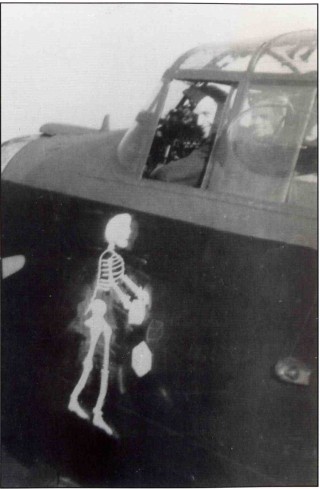
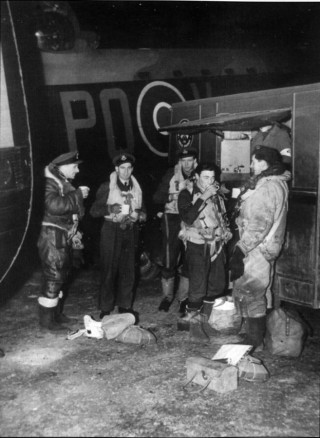
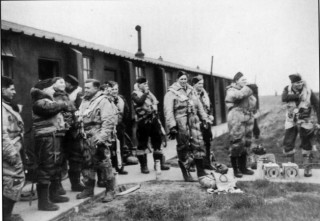
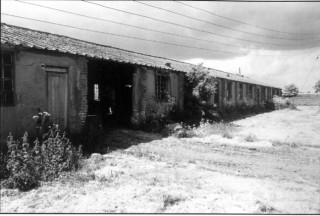
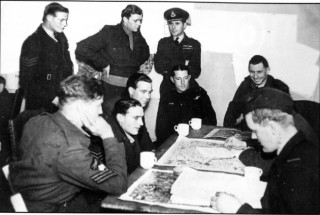
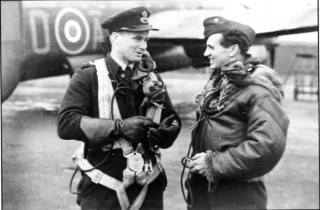








No Comments
Add a comment about this page